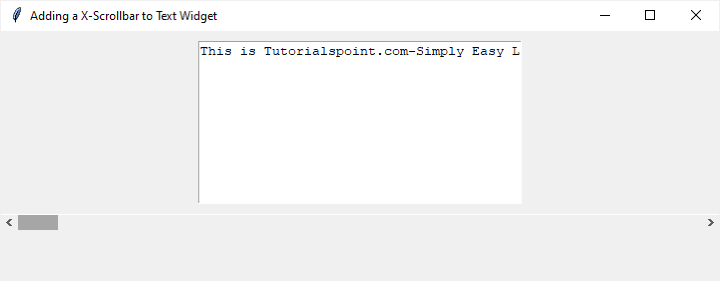
 Data Structure
Data Structure Networking
Networking RDBMS
RDBMS Operating System
Operating System Java
Java MS Excel
MS Excel iOS
iOS HTML
HTML CSS
CSS Android
Android Python
Python C Programming
C Programming C++
C++ C#
C# MongoDB
MongoDB MySQL
MySQL Javascript
Javascript PHP
PHP
- Selected Reading
- UPSC IAS Exams Notes
- Developer's Best Practices
- Questions and Answers
- Effective Resume Writing
- HR Interview Questions
- Computer Glossary
- Who is Who
How to add a xscrollbar to Text widget in Tkinter?
Graphical User Interfaces (GUIs) serve as the visual gateway to user interactions in software applications, and Tkinter stands as a stalwart toolkit for crafting such interfaces in Python. This article delves into a specific aspect of Tkinter - the integration of a horizontal scrollbar (xscrollbar) into a Text widget.
Navigating extensive text content within a confined space is a common challenge, making the addition of a horizontal scrollbar crucial for an improved user experience. Over the course of this tutorial, we will explore a step-by-step approach to seamlessly incorporate this functionality, empowering developers to create more dynamic and user-friendly GUIs for their Python applications.
The Need for Horizontal Scrolling
When dealing with textual content in a Tkinter Text widget, it's common to encounter situations where the width of the text exceeds the visible area of the widget. In such cases, horizontal scrolling becomes crucial to allow users to navigate through the entire content. Let's delve into the steps of implementing a horizontal scrollbar for a Text widget.
Understanding the Text Widget
The Text widget in Tkinter is a versatile component that allows the display and editing of text. It supports various formatting options and can handle large amounts of text. However, when the content extends beyond the widget's width, a scrollbar is needed for effective navigation.
Step 1: Creating the Text Widget
The first step is to create a Tkinter window and add a Text widget to it. We set the wrap option to "none" to ensure that lines of text do not wrap, which is crucial for horizontal scrolling.
import tkinter as tk root = tk.Tk() text_widget = tk.Text(root, wrap="none", width=40, height=10) text_widget.pack(padx=10, pady=10)
In this example, we've set the width and height of the Text widget, but you can adjust these values based on your application's requirements.
Step 2: Creating the Horizontal Scrollbar
To enable horizontal scrolling, we need to add a horizontal scrollbar (xscrollbar) to the Tkinter window. We use the Scrollbar widget and set its orientation to "horizontal."
xscrollbar = tk.Scrollbar(root, orient="horizontal") xscrollbar.pack(fill="x")
The fill="x" option ensures that the scrollbar expands horizontally to fill the available space.
Step 3: Linking the Scrollbar to the Text Widget
Now, we need to establish a connection between the horizontal scrollbar and the Text widget. This is done using the xscrollcommand option of the Text widget, which takes the set method of the scrollbar as its argument.
text_widget.config(xscrollcommand=xscrollbar.set)
Additionally, we need to specify a function that will be called when the scrollbar is moved. This function, commonly named on_scroll, will adjust the view of the Text widget accordingly.
def on_scroll(*args): text_widget.xview(*args) xscrollbar.config(command=on_scroll)
The *args syntax allows the function to accept any number of arguments. In this case, it will be used to pass the scrollbar's position.
Step 4: Inserting Text into the Text Widget
Let's add some sample text to the Text widget to visualize the scrolling in action.
text_widget.insert("1.0", "Lorem ipsum dolor sit amet, consectetur adipiscing elit. " * 10)
Adjust the inserted text according to your application's needs. This step is crucial for testing the scrollbar's functionality.
Step 5: Running the Tkinter Event Loop
Finally, we start the Tkinter event loop to display the window and handle user interactions.
root.mainloop()
Example
Let's put it all together to get the complete implementation code for adding a xscrollbar to Text widget
import tkinter as tk
def on_scroll(*args):
"""
Function to handle scrollbar movement and adjust the view of the Text widget accordingly.
"""
text_widget.xview(*args)
# Create the main Tkinter window
root = tk.Tk()
root.title("Adding a X-Scrollbar to Text Widget")
# Set window dimensions
root.geometry("720x250")
# Step 1: Create a Text widget
text_widget = tk.Text(root, wrap="none", width=40, height=10)
text_widget.pack(padx=10, pady=10)
# Step 2: Create a horizontal scrollbar
xscrollbar = tk.Scrollbar(root, orient="horizontal")
# Step 3: Link the scrollbar to the Text widget
text_widget.config(xscrollcommand=xscrollbar.set)
# Step 4: Configure the scrollbar to call the on_scroll function
xscrollbar.config(command=on_scroll)
# Pack the scrollbar to make it visible
xscrollbar.pack(fill="x")
# Step 5: Insert some text into the Text widget
text_widget.insert("1.0", "This is Tutorialspoint.com-Simply Easy Learning At Your Fingertips. " * 10)
# Start the Tkinter event loop
root.mainloop()
Now let's run the script and we will get a Tkinter window containing a Text widget with a horizontal scrollbar. The scrollbar allows us to navigate through horizontally extended text.
Output

Conclusion
In conclusion, this article has guided you through the process of seamlessly integrating a horizontal scrollbar into a Tkinter Text widget. With an emphasis on clarity and functionality, we covered the fundamental steps?from creating the Text widget and scrollbar to linking them and handling scrolling events. By implementing these techniques, you can enhance the user experience in your Python GUI applications, particularly when dealing with extensive textual content. As you explore Tkinter's customization options further, you'll find opportunities to refine the visual appeal and functionality of your GUIs. The ability to proficiently incorporate scrollbars will undoubtedly contribute to the development of more intuitive and polished graphical interfaces in your projects.

